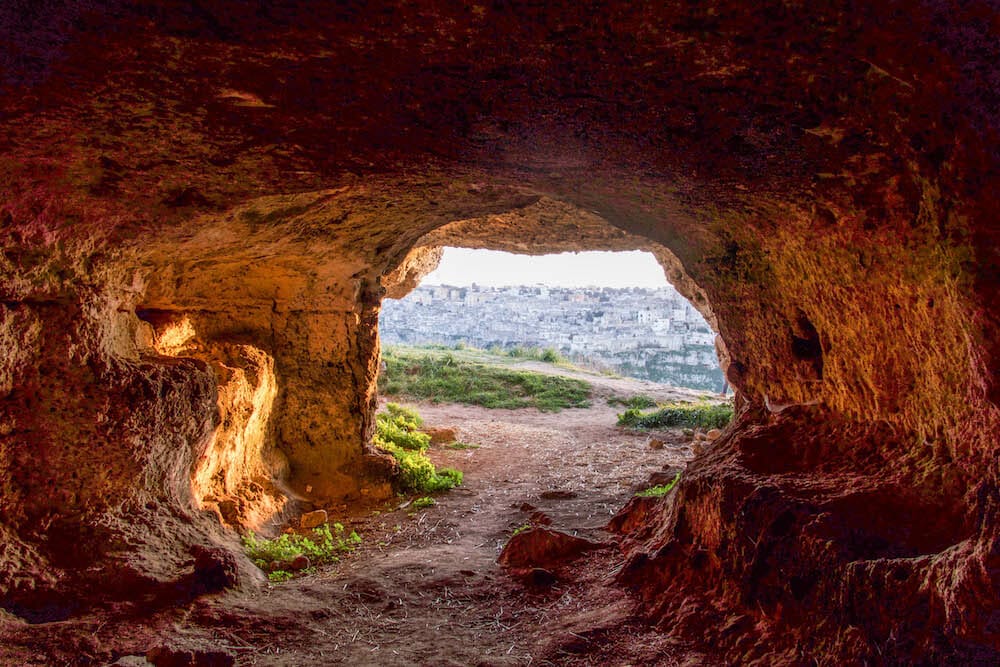MATERA ITALY Tour Highlights –3D Pentimento in Canvas of Caves --in a 2019 European Capital of Culture, also rich with UNESCO World Heritage Sites
If you too treasure get-lost-on-purpose adventures while traveling, Matera’s Sassi –the picturesque hills with topsy-turvy seeming cave houses you see in these pictures- are your dream come true. It’s the kind of place where a purposeful moving from point A to point B seems like an annoying distraction. If instead your meanderings allow you ample time to linger, you can better discover its peephole into Southern Italian history reaching back to pre-biblical times
Pause this photo slider above in between pictures, for example, and dwell on the architectural details. Are those steps on the side of that house leading nowhere? Why do I see the other side of the hill through that newly painted door’s top where there should be a wall? And perhaps the most nagging question--Is that early morning picture really a photograph or is it a pen and ink drawing?
Like painting pentimento-- The Sassi are dotted with stairs that lead nowhere, doors that open to missing rooms, and similar that is more memory than architecture
You are looking at a place so starkly photogenic—and chlorophyll bare-- that it has been used as the backdrop of many a bible-themed movie, most notably Mel Gibson’s The Passion of The Christ. You feel like you are walking in a 3D painting on a canvas that still has pentimento of the sketch before, and the sketch before that, reaching back 7500 years!
Murgia National Park, also a UNESCO World Heritage Site, is dotted with vestigial cave homes and rock churches in greater or lesser repair. Some of these churches are used for religious services on special occasions to this day.
It is also a place that had been a ghost town not so very long ago, when the residents of the disease-ridden Sassi – by then overpopulated by large families that often lived in cave houses with their animals— were forcibly re-located to a new modern part of Matera. The backstory begins with socialist-minded Dr. Carlo Levi—a physician, writer, painter, and political activist—who was banished to Southern Italy’s Basilicata region, then Italy’s equivalent of Siberia. Levi recounted the Sassi’s misery in vivid detail in his book Christ Stopped at Eboli, seeding a perception of everything Sassi being a national shame.
With 20-20 hindsight and anachronistic vision, that clumsy relocation that psychologically scarred a few generations might not have gone down that way if those in power had also properly dialed in the richness of Matera’s communal culture, as they might today. Just consider the Materan recipe for crapiata, a soup made of different types of beans that came about when the families pooled their resources, or the water engineering of shared cisterns, or how families would stamp their bread to mark them for the communal oven. Perhaps broken into shards by the 1950’s, there nonetheless had to be some shared culture able to sustain the people of the Sassi for millennia.
Such considerations are moot today, as evidenced by the supersized construction cranes you now see dotting the landscape, the happy crowds in any number of restaurants, the luxurious modern churches that have supplanted the fascinating rock churches found in the Sassi, fellow UNESCO World Heritage Site Murgia National Park and in other hidden corners in and around Matera- -or even in a funeral procession where real Materans show their sense of community and shared grief. One hears in early 2019 that the Sassi are about 50% re-populated by families, hotels and businesses. One suspects that percentage will ramp up significantly now that the city is a 2019 European Capital of Culture.
Matera Italy circa now is a happening place
True, in the modern part of town you may find many of the same international chain stores with which you are familiar. But with Matera’s exotic Sassi around the corner, you likely will never have that kind of dread today’s global traveler often gets that they might as well have stayed home. You are in a place with improbable curves and rooms burrowed down and beyond from the room in front of them. It’s a living architecture that colors your experience of everything in and around Matera. It is a thrill.
Click a thumbnail below to read more about Matera’s history and the Matera of today from a tourist’s point of view.
